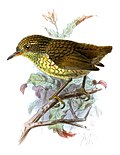| Gavicalis | |
|---|---|
 | |
| Gavicalis virescens (singing honeyeater) | |
| Scientific classification | |
| Kingdom: | Animalia |
| Phylum: | Chordata |
| Class: | Aves |
| Order: | Passeriformes |
| Family: | Meliphagidae |
| Genus: | Gavicalis Schodde & Mason, IJ, 1999 |
| Type species | |
| Melithreptus virescens [1] Vieillot, 1817 | |
Gavicalis is a genus of honeyeaters endemic to New Guinea and Australia. It contains former members of Lichenostomus , and was created after a molecular phylogenetic analysis published in 2011 showed that the original genus was polyphyletic. [2]
The genus contains three species: [3]
| Image | Scientific name | Common name | Distribution |
|---|---|---|---|
 | Gavicalis versicolor | Varied honeyeater | New Guinea, northeast Australia |
 | Gavicalis fasciogularis | Mangrove honeyeater | east Australia |
 | Gavicalis virescens | Singing honeyeater | Australia |
The name Gavicalis was first proposed by the Australian ornithologists Richard Schodde and Ian Mason in 1999. [4] The word is an anagram of Caligavis introduced by Tom Iredale. [5]
